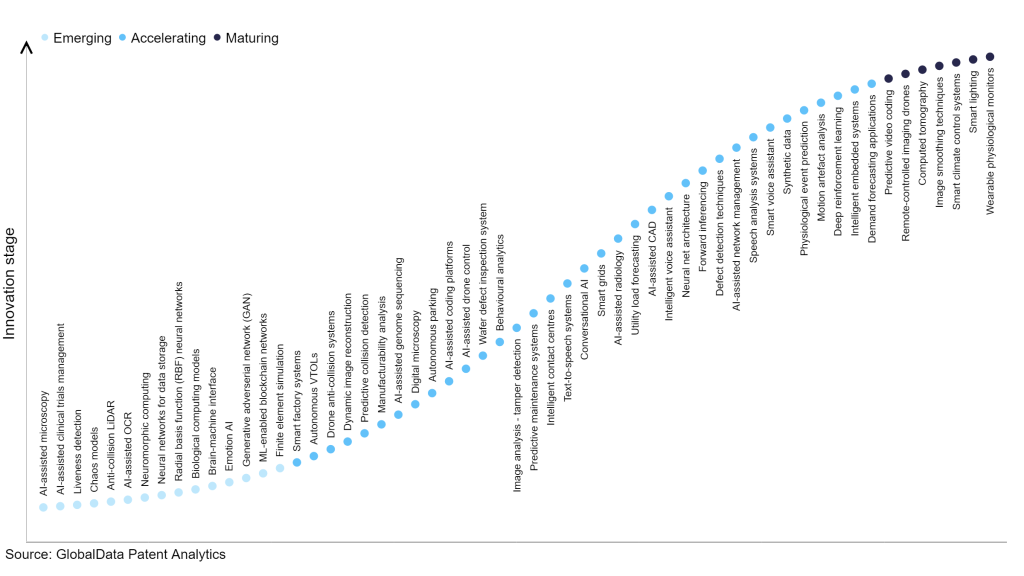The technology industry continues to be a hotbed of innovation, with activity driven by the amalgamation of technological progress, heightened connectivity, and the urgency for businesses to enhance efficiency and competitiveness in an ever-changing marketplace and growing importance of technologies such as computer vision, machine learning, deep learning, and augmented reality. The use of AI technologies in microscopy has the potential to revolutionise the way researchers analyse and interpret their data, leading to more accurate and efficient results. in the last three years alone, there have been over 3.6 million patents filed and granted in the technology industry, according to GlobalData’s report on Innovation in Artificial Intelligence: AI-assisted microscopy. Buy the report here.
However, not all innovations are equal and nor do they follow a constant upward trend. Instead, their evolution takes the form of an S-shaped curve that reflects their typical lifecycle from early emergence to accelerating adoption, before finally stabilising and reaching maturity.
Identifying where a particular innovation is on this journey, especially those that are in the emerging and accelerating stages, is essential for understanding their current level of adoption and the likely future trajectory and impact they will have.
300+ innovations will shape the technology industry
According to GlobalData’s Technology Foresights, which plots the S-curve for the technology industry using innovation intensity models built on over 2.5 million patents, there are 300+ innovation areas that will shape the future of the industry.
Within the emerging innovation stage, finite element simulation, ML-enabled blockchain networks emotion AI, and generative adversarial network (GAN) are disruptive technologies that are in the early stages of application and should be tracked closely. Demand forecasting applications, intelligent embedded systems, and deep reinforcement learning are some of the accelerating innovation areas, where adoption has been steadily increasing. Among maturing innovation areas are wearable physiological monitors, smart lighting, and smart climate control systems, which are now well established in the industry.
Innovation S-curve for artificial intelligence in the technology industry

AI-assisted microscopy is a key innovation area in artificial intelligence
AI-assisted microscopy refers to a microscopy technique that integrates artificial intelligence (AI) to automate and optimise the analysis process. By utilising AI algorithms, AI-assisted microscopy can detect and identify various features of a sample being analysed, providing quantitative information for applications in fields such as pathology, cell biology, and materials science. Compared to traditional microscopy techniques, AI-assisted microscopy has the potential to achieve higher accuracy in object identification, quantification, and classification.
GlobalData’s analysis also uncovers the companies at the forefront of each innovation area and assesses the potential reach and impact of their patenting activity across different applications and geographies. According to GlobalData, there are 80 companies, spanning technology vendors, established technology companies, and up-and-coming start-ups engaged in the development and application of AI-assisted microscopy.
Key players in AI-assisted microscopy – a disruptive innovation in the technology industry
‘Application diversity’ measures the number of different applications identified for each relevant patent and broadly splits companies into either ‘niche’ or ‘diversified’ innovators.
‘Geographic reach’ refers to the number of different countries each relevant patent is registered in and reflects the breadth of geographic application intended, ranging from ‘global’ to ‘local’.
Patent volumes related to AI-assisted microscopy
Source: GlobalData Patent Analytics
Heartflow is a leading patent filer in in AI-assisted microscopy. The company’s patents are aimed at a system for determining cardiovascular information of a patient. The system may include at least one computer system configured to receive patient-specific data regarding a geometry of the patient's heart and create a three-dimensional model representing at least a portion of the patient's heart based on the patient-specific data. At least, one computer system may be further configured to create a physics-based model relating to a blood flow characteristic of the patient's heart and determine a fractional flow reserve within the patient's heart based on the three-dimensional model and the physics-based model. The other prominent patent filers in the space include F. Hoffmann-La Roche and Siemens.
In terms of geographical reach, Terumo leads the pack, followed by Room4 Group and ClearLight Biotechnologies. In terms of application diversity, Alentic Microscience holds the top position, followed by Horiba and CellPly.
AI-assisted microscopy is a significant advancement in microscopy due to its ability to provide faster, more accurate, and automated analysis of samples. By incorporating AI algorithms, AI-assisted microscopy can optimise the analysis process, resulting in more precise detection and identification of features within a sample.
To further understand how artificial intelligence is disrupting the technology industry, access GlobalData’s latest thematic research report on Artificial Intelligence (AI) – Thematic Intelligence.
Data Insights
From

The gold standard of business intelligence.
Blending expert knowledge with cutting-edge technology, GlobalData’s unrivalled proprietary data will enable you to decode what’s happening in your market. You can make better informed decisions and gain a future-proof advantage over your competitors.






